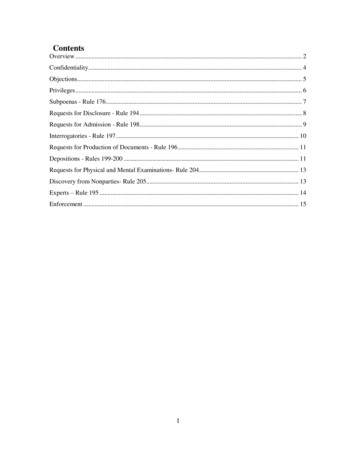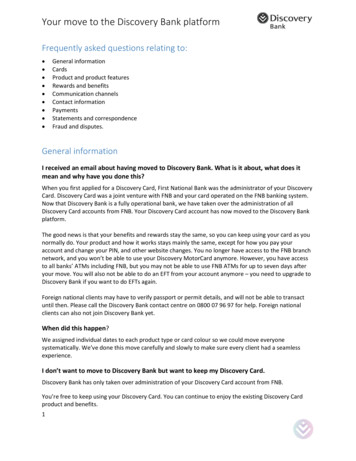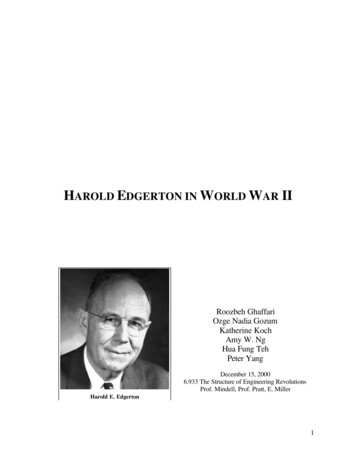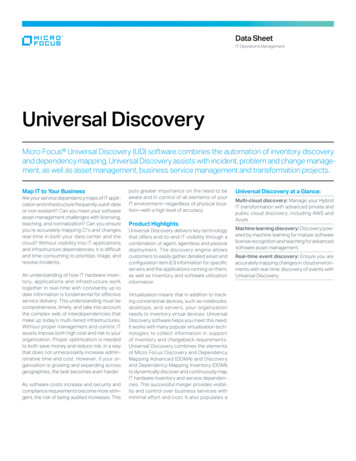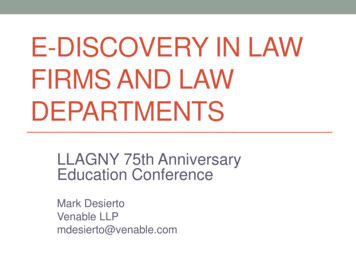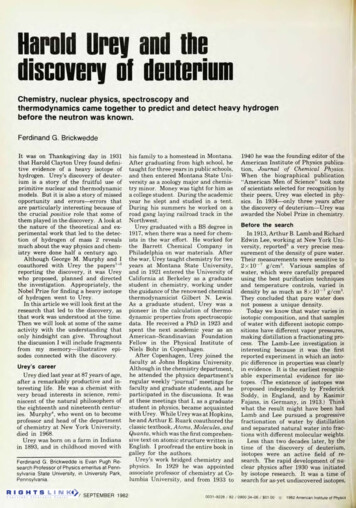
Transcription
Harold Urey and thediscovery of deuteriumChemistry, nuclear physics, spectroscopy andthermodynamics came together to predict and detect heavy hydrogenbefore the neutron was known.Ferdinand G. BrickweddeIt was on Thanksgiving day in 1931that Harold Clayton Urey found definitive evidence of a heavy isotope ofhydrogen. Urey's discovery of deuterium is a story of the fruitful use ofprimitive nuclear and thermodynamicmodels. But it is also a story of missedopportunity and errors—errors thatare particularly interesting because ofthe crucial positive role that some ofthem played in the discovery. A look atthe nature of the theoretical and experimental work that led to the detection of hydrogen of mass 2 revealsmuch about the way physics and chemistry were done half a century ago.Although George M. Murphy and Icoauthored with Urey the papers1"3reporting the discovery, it was Ureywho proposed, planned and directedthe investigation. Appropriately, theNobel Prize for finding a heavy isotopeof hydrogen went to Urey.In this article we will look first at theresearch that led to the discovery, asthat work was understood at the time.Then we will look at some of the sameactivity with the understanding thatonly hindsight can give. Throughoutthe discussion I will include fragmentsfrom my memory—illustrative episodes connected with the discovery.Urey's careerUrey died last year at 87 years of age,after a remarkably productive and interesting life. He was a chemist withvery broad interests in science, reminiscent of the natural philosophers ofthe eighteenth and nineteenth centuries. Murphy4, who went on to becomeprofessor and head of the departmentof chemistry at New York University,died in 1968.Urey was born on a farm in Indianain 1893, and in childhood moved withFerdinand G. Brickwedde is Evan Pugh Research Professor of Physics emeritus at Pennsylvania State University, in University Park,Pennsylvania.34PHYSICS TODAY / SEPTEMBER 1982his family to a homestead in Montana.After graduating from high school, hetaught for three years in public schools,and then entered Montana State University as a zoology major and chemistry minor. Money was tight for him asa college student. During the academicyear he slept and studied in a tent.During his summers he worked on aroad gang laying railroad track in theNorthwest.Urey graduated with a BS degree in1917, when there was a need for chemists in the war effort. He worked forthe Barrett Chemical Company inPhiladelphia on war materials. Afterthe war, Urey taught chemistry for twoyears at Montana State University,and in 1921 entered the University ofCalifornia at Berkeley as a graduatestudent in chemistry, working underthe guidance of the renowned chemicalthermodynamicist Gilbert N. Lewis.As a graduate student, Urey was apioneer in the calculation of thermodynamic properties from spectroscopicdata. He received a PhD in 1923 andspent the next academic year as anAmerican-Scandinavian FoundationFellow in the Physical Institute ofNiels Bohr in Copenhagen.After Copenhagen, Urey joined thefaculty at Johns Hopkins University.Although in the chemistry department,he attended the physics department'sregular weekly "journal" meetings forfaculty and graduate students, and heparticipated in the discussions. It wasat these meetings that I, as a graduatestudent in physics, became acquaintedwith Urey. While Urey was at Hopkins,he and Arthur E. Ruark coauthored theclassic textbook, Atoms, Molecules, andQuanta, which was the first comprehensive text on atomic structure written inEnglish. I proofread the entire book ingalley for the authors.Urey's work bridged chemistry andphysics. In 1929 he was appointedassociate professor of chemistry at Columbia University, and from 1933 to1940 he was the founding editor of theAmerican Institute of Physics publication, Journal of Chemical Physics.When the biographical publication"American Men of Science" took noteof scientists selected for recognition bytheir peers, Urey was elected in physics. In 1934—only three years afterthe discovery of deuterium—Urey wasawarded the Nobel Prize in chemistry.Before the searchIn 1913, Arthur B. Lamb and RichardEdwin Lee, working at New York University, reported5 a very precise measurement of the density of pure water.Their measurements were sensitive to2xlO 7 g/cm3. Various samples ofwater, which were carefully preparedusing the best purification techniquesand temperature controls, varied indensity by as much as 8xlO 7 g/cm3.They concluded that pure water doesnot possess a unique density.Today we know that water varies inisotopic composition, and that samplesof water with different isotopic compositions have different vapor pressures,making distillation a fractionating process. The Lamb-Lee investigation isinteresting because it was the firstreported experiment in which an isotopic difference in properties was clearlyin evidence. It is the earliest recognizable experimental evidence for isotopes. (The existence of isotopes wasproposed independently by FrederickSoddy, in England, and by KasimirFajans, in Germany, in 1913.) Thinkwhat the result might have been hadLamb and Lee pursued a progressivefractionation of water by distillationand separated natural water into fractions with different molecular weights.Less than two decades later, by thetime of the discovery of deuterium,isotopes were an active field of research. The rapid development of nuclear physics after 1930 was initiatedby isotope research. It was a time ofsearch for as-yet undiscovered isotopes,0031-9228/ 8 2 / 0900 3 4 - 0 6 / 01.00(cl1982 American Institute Of Physics
especially of the light elements, hydrogen included, and Urey was very mucha participant.I remember a conversation in 1929with Urey and Joel Hildebrand, a famous professor of chemistry at Berkeley.It took place during a taxi ride betweentheir hotel and the conference centerfor a scientific meeting we were attending in Washington. When Urey askedHildebrand what was new in researchat Berkeley, Hildebrand replied thatWilliam Giauque and Herrick Johnston had just discovered that oxygenhas isotopes with atomic weights 17and 18, the isotope of weight 18 beingthe more abundant. Their paper6would appear shortly in the Journal ofthe American Chemical Society. ThenHildebrand added, "They could nothave found isotopes in a more important element." Urey responded: "No,not unless it was hydrogen." This wastwo years before the discovery of deuterium. Urey did not remember thisremark, but I did.At the time, answers were beingsought to questions such as: Why doisotopes exist, and what determinestheir number, relative abundances andmasses (packing fractions)?Urey, along with others, constructedcharts of the known isotopes to showrelationships bearing on their existence. The figure on page 36 is one ofUrey's charts. At the time, the neutronhad not been discovered—it was discovered in 1932, the year after deuterium. The chart was based on the theory that atomic nuclei were composedof protons, plotted here as ordinates,and nuclear electrons, plotted as abscissae—the number of protons was thenuclear mass number, and the numberof nuclear electrons was the number ofprotons minus the atomic number ofthe element. In Urey's chart, the filledcircles represent the nuclei from H' toSi30 that were known to exist before1931. The open circles represent nucleiunknown before 1931. The chart's pattern of staggered lines, when extendeddown to H1, suggested to Urey that theatoms H2, H3 and He5 might existbecause they are needed to completethe pattern.Urey had a copy of this chart hanging on a wall of his laboratory. Theisotope helium-5 does not exist, and thestaggered line does not provide a placefor the isotope helium-3, which wasdiscovered later. The diagram is onlyof historical interest now, but it was anincentive to Urey to look for a heavyisotope of hydrogen.Prediction and evidenceIn 1931—the year of the discovery ofdeuterium—Raymond T. Birge, a professor of physics at the University ofCalifornia, Berkeley, and Donald H.Menzel, professor of astrophysics atLick Observatory, published7 a letter tothe editor in Physical Review on therelative abundances of the oxygen isotopes in relation to the two systems ofatomic weights that were then in use—the physical system and the chemicalsystem. Atomic weights in the physicalsystem were determined with the massspectrograph and were based on settingthe atomic weight of the isotope O16 atexactly 16. In the chemical system,atomic weights were determined byHarold Clayton Urey and a country schoolhouse in Indiana where he taughtafter graduating from high school. Urey taught for three years in public schoolsin Indiana and Montana before he entered Montana State University.(Schoolhouse photo from the Urey collection, AIP Niels Bohr Library.)PHYSICS TODAY / SEPTEMBER 198235
bulk techniques, and the values werebased on setting at 16 the atomicweight of the naturally occurring mixture of oxygen isotopes, O16, O17 andO18. Thus the atomic weights of asingle isotope or element on the twoscales should differ. The weightnumbers should be greater on the physical scale.However, in 1931 the atomic weightsof hydrogen on the two scales were thesame within the claimed experimentalerrors. The chemical value was1.00777 0.00002. The mass-spectrographic value, determined by FrancisW. Aston of the Cavendish Laboratory,was 1.00778 0.00015. Birge andMenzel pointed out that the near coincidence of these two atomic weightsleads to the conclusion that normalhydrogen is a mixture of isotopes—H1in high concentration and a heavy isotope in low concentration. The atomicweight was not higher on the physicalscale because the mass-spectroscopictechniques saw only the light isotope.To the heavy isotope they gave thesymbol H2, perhaps the first time thissymbol occurred in the literature. Assuming the atomic weight of heavyhydrogen to be two, Birge and Menzelcalculated its relative abundance fromthe supposed equivalence of the atomicweights of hydrogen-1 on the physicalscale and the normal mixture of hydrogen isotopes on the chemical scale.They obtained 1/4500 for the abundance of H2 relative to H1.Within a day or two at most afterreceiving the 1 July 1931 issue of thePhysical Review, Urey proposed andplanned an investigation to determineif a heavy isotope of hydrogen did reallyexist.Urey and Murphy, working at Columbia, identified hydrogen and its isotope spectroscopically, using theBalmer series lines. The atomic spectrum was produced with a Wood's electric discharge tube operated in the socalled black stage—the configurationof current and pressure that moststrongly excites hydrogen's atomicspectrum relative to its molecular spectrum. They observed the spectra witha 21-foot grating, in the second order.The dispersion was 1.3 A per mm. Theexpected shifts, then, were of the orderof 1 mm, as the numbers in the tableindicate. The vacuum wavelengths ofdeuterium's lines were calculated using the Balmer series formulal/AH RH(l/22-l/n2)n 3, 4, 5 , . . .RH (2irIe4/h3c)memH/(mf!10NUCLEAR ELECTRONSProtons versus "nuclear electrons" foratomic nuclei from H1 to Si30. The plot shows apattern that led Urey to look for a heavyisotope of hydrogen. Open circles representnuclei that were unknown in 1931, when thechart was produced.termined by comparing the measuredtimes required to produce plate lines ofH and D of equal photographic densities. The exposure times for H/? and Hywere about 1 second.Using cylinder hydrogen, Urey andMurphy found very faint lines at thecalculated positions for D/?, T)y and D 5.The lines were faint because of the lowconcentration of deuterium in normalhydrogen. There was a possibility thatthe new lines arose from impurities, orwere grating ghost lines arising fromthe relatively intense hydrogen Balmerspectrum.(1) mH)and the "best" values for the atomicconstants. The Balmer a-lines of hydrogen and deuterium are separated by1.8 A, the /?-lines by 1.3 A, and the ylines by 1.2 A. The concentrations ofdeuterium relative to hydrogen are de3615PHYSICS TODAY / SEPTEMBER 1982Clinching evidenceence in the vapor pressures of solid H2and HD. On this basis Urey expected asizeable difference in the vapor pressures of liquid H2 and HD at 20.4 K, theboiling point of H2.Urey approached me at the NationalBureau of Standards in Washington,inviting me to join the search for aheavy isotope of hydrogen by evaporating 5- to 6-liter quantities of liquidhydrogen to a residue of 2 cm3 of liquid,which would be evaporated into glassflasks and sent by Railway Express toColumbia University for spectroscopicexamination. At the time, 1931, therewere only two laboratories in the United States where liquid hydrogen wasavailable in 5- or 6-liter quantities.One was the National Bureau of Standards in Washington and the other wasGiauque's laboratory at the Universityof California, Berkeley. I was happy tocooperate, and I prepared—by distilling liquid hydrogen at the Bureau ofStandards—the samples of gas inwhich the heavy isotope was identified.The first sample I sent to Urey wasevaporated at 20 K and a pressure ofone atmosphere. It showed no appreciable increase in intensity of the spectral lines attributed to heavy hydrogen.This was unexpected.The next samples were evaporated ata lower temperature—14 K at 53 mm ofmercury pressure, the triple point ofH2—where the relative difference inthe vapor pressures of H2 and HD wasexpected to be larger than at 20 K, andthe rate at which heavy hydrogen isconcentrated was expected to be morerapid.These samples showed 6- or 7-foldincreases in the intensities of theBalmer lines of deuterium. On thisbasis, it could be concluded that thelines in the normal hydrogen spectrumattributed to deuterium were reallydeuterium lines, but the clinching evidence was finding that the photographic image of the Da line—the mostintense D-Balmer line—was a partiallysplit doublet as predicted by theory forthe Balmer series spectrum.From measurements of the relativeintensities of the H and D Balmerseries lines, Urey estimated that therewas one heavy atom per 4500 lightatoms in normal hydrogen. Later measurements showed it to be nearer one in6500.Urey decided not to rush into print tostake a claim to priority in this important discovery; he decided to postponepublication until he had conclusive evidence that the "new" spectral linesattributed to the heavy isotope wereauthentic and not impurity or ghostlines. This evidence could be obtainedby increasing the deuterium concentration in the hydrogen filling the Wood'stube and looking for an increase inintensity of the deuterium Balmer linesrelative to the hydrogen Balmer lines.After careful consideration of different methods for increasing the deuterium concentration, Urey decided on adistillation that would make use of ananticipated difference in the vaporpressures of liquid H2 and liquid HD.He made a statistical, thermodynamiccalculation of the vapor pressures of Unraveling a comedy of errorssolid H2 and solid HD at the triple pointIt is now clear why the first distilledof H2, 14 kelvins, where the liquid and hydrogen sent to Urey did not show thecrystal phases of H2 are in equilibrium expected increase in the deuteriumand have the same vapor pressure. The concentration, and maybe even showedcalculation was based on the Debyetheory of solids and the zero-point vibrational energy of the solid, 9R6/8 inNews story on the awarding of the 1934the Debye notation. At 14 K, the calcu- Nobel Prize in chemistry. Article appeared 16lated ratio of vapor pressures, P(HD)/November 1934. (Copyright The New YorkP(H2), is 0.4, indicating a large differTimes. Reprinted by permission.)
a small decrease. The explanationcame with the discovery of the electrolytic method for separating H and D,suggested by Edward W. Washburn,chief chemist at the National Bureau ofStandards, and verified8 experimentally by Washburn and Urey just after thepublication of our April 1932 paper.3When Urey considered differentmethods for concentrating deuterium,he included the electrolytic method,and discussed it with Victor LaMer, acolleague at Columbia, and a worldauthority on electrochemistry. LaMerwas so discouraging about success inseparating hydrogen isotopes by electrolysis that Urey abandoned the electrolytic method and adopted the distillation method. LaMer reasoned thatthe differences in equilibrium concentrations of isotopes at the electrodes ofa cell at room temperature would bevery small and hence a fractionation ofthe isotopes would be negligible.Washburn viewed the situation differently. He pointed to the large relative difference in atomic weights of thehydrogen isotopes—a relative difference that is much larger for the hydrogen isotopes than for the isotopes of anyother element. Hence, thought Wash-NOBEL AWARD GOESColumbia Scientist Gets the1934 Chemistry Prize forDiscovering 'Heavy Water.'ACHIEVEMENT WAS HAILEDSeen as of Especial Value inCancer Study—Has ProvedGreat Spur to Research.Calculated Balmer series .117These values were calculated using equation 1 with MH 1.007775 g Mo 2 01363 gm0 5.491 M O * g and flH 109677.759 cm 'burn, the hydrogen isotopes might behave differently from the isotopes ofother elements.Washburn, the empiricist, was right;the isotopes of hydrogen are separatedrelatively easily by electrolysis, butthis was not realized until after thediscovery of deuterium.The hydrogen we liquefied and distilled for Urey was generated electrolytically. Before preparing thefirstsample for Urey, the electrolytic generatorwas completely dismantled, cleanedand filled with a freshly prepared solution of sodium hydroxide. Because deuterium becomes concentrated in theelectrolyte in the generator, the firstgaseous hydrogen to be discharged was06FOConSiDIVOIMrs.ThSpeBUFJment isions odeficient in deuterium. The concentration of deuterium in the hydrogenevolved was about one sixth the concentration of deuterium in the electrolyte,and hence about one sixth the concentration of deuterium in normal hydrogen. Distillation of the deuterium-deficient liquid hydrogen increased theconcentration of D relative to H andrestored in the first sample approximately the original concentration ofdeuterium in normal hydrogen.As electrolysis progressed, water wasadded to replace that which was consumed. The concentration of deuterium in the electrolyte increased to thepoint where the rate at which deuterium left the generator balanced therate at which it arrived in the addedwater. Hence, after the electrolyticgenerator had been in use for sometime, there was a dynamic equilibrium;so the hydrogen evolved from the generator for our second and third samplesfor Urey had approximately the normal concentration of deuterium.When we liquefied this hydrogen andevaporated 5 or 6 liters down to 2 cm3,the concentration of deuterium in theresidue was increased by a factor ofabout six.Here we lower the curtain on a "comedy of errors"—LaMer's error of notunderstanding better the principlesthat govern isotopic fractionation during electrolysis, and my error of attributing to sloppy technique our failure toeffect an increase of deuterium concentration in the first sample we sent toUrey. Had I analyzed our part of theprocess, I think we might have discovered the electrolytic concentration ofdeuterium. Had LaMer been moreknowledgeable, Urey would have madehis own concentration of deuteriumelectrolytically and I should have hadno part in the discovery of deuterium.Wireless to THE NEW YORK TIMES.by OgdSTOCKHOLM, Nov. 15.—The, TreasuNobel Prize in Chemistry for 1934in addWINS NOBEL PRIZE.was awarded today to Professorwelf?Harold C. Urey of Columbia UniProfessor Harold Urey.businversity because of his discovery ofation"heavy water."HeDEFENSETOSUBPOENAThe chemistry prize for 1933 willder StReporting the resultnot be awarded. It was also an- LINDBERGH FOR TRIAL times oAfter the discovery of deuterium,nounced that there would be noin timesUrey faced a very practical problem inprize in physics for this year.wouldbfBetty Gow Also to Be Summoned Speakreporting it—a problem characteristicAchievement Was Hailed.as Witness—Fight Planned to Mrs. Cof the status of research before WorldDr. Harold Clayton Urey won adentWar II. Urey's research at Columbia,Release Haaptmann Funds. urgeposition in the forefront amongand ours at the National Bureau ofacientists by his discovery of "heavyprolSpecial to THE NEW YORK TIMES.Standards, where I was chief of the lowwater," which has been hailed by FLEMINGTON,N. J., Nov. 15.— birttemperature laboratory, was carriedscientists the world over as ranking Colonel Charles A. Lindbergh and unfamong the great achievements of Betty Gow, w out without the support of any govern fir t son'sjModern science.ment research grant. It was said that urse, will ' deThe Willard Gil- Med?'i s e Chicago sectionChemicp'PHYSICS TODAY / SEPTEMBER 1982 37Dr. *
research in that period was done withstring and sealing wax; it was in factdone mostly with homemade apparatus. The US government policy ofgrants in support of research datesfrom a later time—from World War II.Before the War it was a problem tofind funds for travel to scientific meetings. I received a telephone call fromUrey, telling me that it appeared hewas not going to get funds to travel tothe December 1931 American PhysicalSociety meeting at Tulane University,where he planned to present a paperreporting the discovery of deuterium.He asked me if I could get travel fundsand present the paper. For this I had tosee Lyman J. Briggs, assistant directorof research and testing at the Bureau ofStandards. Briggs, soon to be namedNBS director, was an understandingand considerate physicist who, onlearning of the work to be reported,made funds available for my travel. Inthe meantime, Bergen Davis, a prominent physicist at Columbia, heard ofUrey's problem and went to see Columbia president Nicholas Murray Butler,who made funds available for Urey'stravel. So we both went to Tulane forthe APS meeting, and Urey presentedthe ten-minute paper.1 Over the nextfew months we published more detailin a letter2 to the editor and a fulllength paper3 in Physical Review.I remember asking Birge at a laterAPS meeting why he and Giauque hadnot followed up on his prediction7 of theexistence of heavy hydrogen. Theymight have demonstrated the existenceof deuterium by concentrating theheavy isotope through distillation of alarge quantity of liquid hydrogen asUrey and I had done. Giauque had avery fine, large-capacity hydrogen liquefier suitable for this. Birge's replywas that he was busily engaged onother important work that demandedhis attention. When I told Urey of thisdiscussion, his comment was: "What inthe world could Birge have been working on that was so important?"Apropos of the above, I quote herefrom a letter of 6 May 1981 from RobertW. Birge, son of Raymond T. Birge, andalso a physicist:After reading some more about myfather's life, I think I know why hedidn't try to concentrate deuterium. I believe he was an analystmore than a hardware builder andit probably never occurred to himto do it that way. He said that atthe time several people were trying to see the deuterium lines inspectra, but they [Urey, Brickwedde and Murphy] did it first.But as you know, the importantpoint was that Urey realized that[the concentration of] deuteriumcould be enhanced.The two men remained friends38Mass spectrometer with Urey at the controls, after the discovery of deuterium. (Photographcourtesy of King Features Syndicate.)throughout their lifetime.Frederick Soddy, the English chemist who received the 1921 Nobel Prizein Chemistry for discovering the phenomenon of isotopy, did not accept thenotion that deuterium was an isotope ofhydrogen. Soddy worked with isotopesof the naturally radioactive elements,whose atomic weights are large andwhose isotopic relative mass differences are small. These isotopes showedno observable differences in chemicalproperties and were inseparable chemically. When Soddy coined the wordisotope he gave it a definition thatincluded chemical inseparability of isotopic species of the same element. Thiswas generally accepted before the discovery of the neutron in 1932.After the discovery of the neutron,isotopes were denned as atomic specieshaving the same number of protons intheir nuclei but different numbers ofneutrons. But Soddy stuck to chemicalinseparability as a criterion for isotopes and therefore refused to recognize deuterium as an isotope of hydrogen. For Soddy, deuterium was aspecies of hydrogen, with differentatomic weight, but not an isotope ofhydrogen.A fortunate mistakeFour years after the discovery ofdeuterium, Aston reported9 an error inPHYSICS TODAY / SEPTEMBER 1982his earlier mass-spectrographic valueof 1.00778 for the atomic weight ofhydrogen-1 on the physical scale—thevalue used by Birge and Menzel in their1931 letter.7 The revised value on thephysical scale was 1.00813, which corresponds to 1.0078 on the chemicalscale, in agreement with the then current value for the atomic weight ofhydrogen (1.00777) on the chemicalscale. There was then no need or placefor a heavy isotope of hydrogen. Theconclusion of Birge and Menzel wasthus rendered invalid. Indeed, on thebasis of Aston's revised value, Birgeand Menzel would have been obliged toconclude that, if anything, there was alighter—not a heavier—isotope of hydrogen.The prediction of Birge and Menzelof a heavy isotope of hydrogen wasbased on two incorrect values for theatomic weight of hydrogen, namely Aston's mass-spectrographic value andthe chemical value, which also shouldhave been greater. We are obliged toconclude that the experimental errorin the determination of the atomicweights exceeded the difference in theatomic weights on the two scales.Urey was not aware of this when heplanned his experiment. It was notuntil 1935 when Urey's Nobel lecturewas in proof that Aston published hisrevised value. Urey added the follow-
ing to the printed Nobel lecture:AddendumSince this [Nobel lecture10] waswritten, Aston has revised hismass-spectrographic atomicweight of hydrogen (H) to 1.0081instead of 1.0078. With this massfor hydrogen, the argument byBirge and Menzel is invalid. However, I prefer to allow the argument of this paragraph [the thirdparagraph of Urey's Nobel lecture]to stand, even though it now appears incorrect, because this prediction was of importance in thediscovery of deuterium. Withoutit, it is probable we would not havemade a search for it and the discovery of deuterium might have beendelayed for some time.Needless to say, Urey and his colleagues were very glad that an error ofthis kind had been made. Aston saidthat he did not know what the moral ofit all was. He would hardly advisepeople to make mistakes intentionally,and he thought perhaps the only thingto do was to keep on working.Impact of the discoveryIt has been said that Nobel prizes inphysics and chemistry are awarded forwork, experimental or theoretical, thathas made a significant change in ongoing work and thinking in science. Theannouncement that Urey was chosenas the 1934 laureate in chemistry cameless than three years after that tenminute paper in New Orleans announcing the discovery of deuterium. Thisuncommonly early award followed aspectacular display in deuterium-related research. In the first two-year period following the discovery, more than100 research papers were published onor related to deuterium and its chemical compounds, including heavy water.And there were more than a hundredmore11 in the next year, 1934.The use of deuterium as a tracermade it possible to follow the course ofchemical reactions involving hydrogen.This was especially fruitful in investigations of complex physiological processes and in medical chemistry, as inthe breakdown of fatty tissue and incholesterol metabolism.Also, the discovery of heavy hydrogen provided a new projectile, the deuteron, for nuclear bombardment experiments. The deuteron provedmarkedly efficient in disintegrating anumber of light nuclei in novel ways.As the deuteron, with one proton andone neutron, is the simplest compoundnucleus, studies of its structure and ofits proton-neutron interaction took onfundamental importance for nuclearphysics.Many of the early research papersdealt with isotopic differences in physical and chemical properties. Theoriesdeveloped for the atomic mass dependence of physical and chemical properties were tested experimentally. Theseinvestigations were especially interesting because, before the discovery ofdeuterium, chemical properties weregenerally supposed to be determined bythe number and configuration of theextranuclear electrons, quantities thatare identical for isotopes of the sameelement. It had not been realized thatchemical properties are also affected—but to a lesser degree—by the mass ofthe nucleus.In thinking about Urey's search fordeuterium, beginning with his earlydiagram of the isotopes, I am remindedof the Greek inscription on the facadeof the National Academy of Sciencesbuilding in Washington, taken fromAristotle:The search for truth is in one wayhard and in another easy, for it isevident that no one can master itfully or miss it wholly. But eachadds a little to our knowledge ofnature, and from all the facts assembled there arises a certaingrandeur.* * */ wish to acknowledge the valuable assistance of my wife, Langhorne Howard Brickwedde, especially for her help in recallingincidents of the early thirties connected withthe discovery of deuterium. This article isbased on a paper I presented 22 April 1981 inBaltimore, Maryland, at the inaugural session of the American Physical Society's Division of History of Physics.References1. The thirty-third annual meeting of theAmerican Physical Society at TulaneUniversity, 29-30 December 1931.
Harold Urey and the discovery of deuterium Chemistry, nuclear physics, spectroscopy and thermodynamics came together to predict and detect heavy hydrogen before the neutron was known. Ferdinand G. Brickwedde It was on Thanksgiving day in 1931 that Harold Clayton Urey found defini-tive evidence of a heavy isotope of hydrogen. Urey's discovery of .



